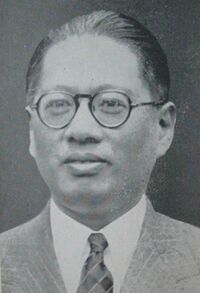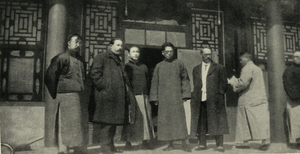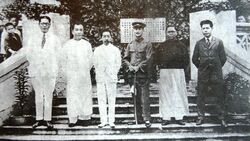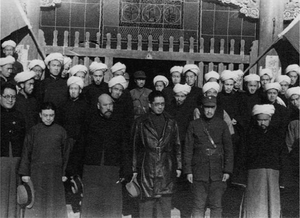ت. ڤ. سونغ
T. V. Soong | |
|---|---|
宋子文 | |
 | |
| رئيس وزراء جمهورية الصين | |
| في المنصب 31 مارس 1945 – 1 مارس 1947 | |
| الرئيس | تشيانگ كاي-شك |
| سبقه | تشيانگ كاي-شك |
| خلـَفه | تشيانگ كاي-شك (القائم بالأعمال) |
| القائم بأعمال رئيس وزراء جمهورية الصين | |
| في المنصب 25 September 1930 – 18 November 1930 | |
| الرئيس | Chiang Kai-shek |
| نائب الوزير الأول | Himself |
| سبقه | Tan Yankai |
| خلـَفه | Chiang Kai-shek |
| نائب رئيس وزراء جمهورية الصين | |
| في المنصب 29 January 1932 – 4 November 1933 | |
| الوزير الأول | Wang Jingwei |
| سبقه | Chen Mingshu |
| خلـَفه | Kung Hsiang-hsi |
| في المنصب 11 October 1930 – 16 December 1931 | |
| الوزير الأول | Himself (acting) Chiang Kai-shek |
| سبقه | Feng Yuxiang |
| خلـَفه | Chen Mingshu |
| تفاصيل شخصية | |
| وُلِد | Soong Tse-vung 4 ديسمبر 1894 St Luke's Hospital, Shanghai International Concession |
| توفي | 25 أبريل 1971 (aged 76)[1] سان فرانسيسكو، كاليفورنيا، الولايات المتحدة |
| المثوى | Ferncliff Cemetery and Mausoleum, Hartsdale, Westchester County, New York, US |
| القومية | جمهورية الصين |
| الحزب | Kuomintang |
| الزوج | Lo-Yi Chang |
| الوالدان | تشارلي سونگ و Nyi Kwei-twang (Ni Kwei-tseng) |
| المدرسة الأم | Harvard University Columbia University |
Soong Tse-vung, more commonly romanized as Soong Tse-ven or Soong Tzu-wen (Chinese: 宋子文; pinyin: Sòng Zǐwén; 4 December 1894 – 25 April 1971), was a prominent businessman and politician who was the Premier of China and a banker.
النشأة والتعليم
T. V. Soong was born at St.Luke's Hospital in Shanghai International concession,[2] He was received his education at St. John's University in Shanghai before he completed a bachelor's degree in economics from Harvard University in 1915. He worked at the International Banking Corporation in New York while pursuing graduate studies at Columbia University.[3] His sisters, known collectively as the Soong Sisters, married well: one married a Yale man from a leading family of Chinese bankers who would eventually become Premier of the Republic of China, H. H. Kung; another became the wife of Sun Yat-sen, founder and leader of the Chinese nationalist independence movement; and yet another became the world-famous wife of Chiang Kai-shek known colloquially as Madame Chiang.
السيرة

Upon returning to China he worked for several industrial enterprises, and was then recruited by Sun Yat-sen to develop finances for his Canton government. After the success of Chiang Kai-shek's Northern Expedition in 1927, Soong served in a succession of offices in the Nationalist Government,[4] including governor of the Central Bank of China (1928–1934) and minister of finance (1928–1933).[5]
He founded the China Development Finance Corporation (CDFC) in 1934, along with other prominent financial figures, such as Chang Kia-ngau, Chen Guangpu and H.H. Kung. CDFC provided China's chief access to foreign investment for the next decade. In the summer of 1940, Chiang appointed Soong to Washington, D.C., as his personal representative. His task was to win support for China's war with Japan. Soong successfully negotiated substantial loans for this purpose. After Pearl Harbor, Chiang appointed Soong Minister of Foreign Affairs, though Soong remained in Washington to manage the alliance with both the U.S. and the U.K.
During his tenure as Finance Minister, he managed to balance China's budget, which was no small accomplishment. He resigned in 1933, displeased with Chiang Kai-shek's appeasement of Japan and attempts to placate Japanese aggression.[6] He later returned to service as Minister of Foreign Affairs (1942–1945), and as President of the Executive Yuan (1945–1947). Soong left his legacy as head of the Chinese delegation to the United Nations Conference on International Organization in San Francisco, April 1945, which later became the United Nations.
During the German invasion of Russia, Soong was in charge of negotiating with the Soviet leader Joseph Stalin regarding Soviet interests in China, and travelled to Moscow to extract from Stalin a guarantee to oppose the Chinese Communist Party. Soong conceded to Stalin the Manchurian railways and Korean independence[بحاجة لمصدر] but refused to allow Soviet interference in Xinjiang or military bases in Manchuria. He also indicated that China and the Soviet Union could share dominion over Mongolia if a "mutual assistance pact" was agreed to.[7] Soong was known for his tough negotiating style with Stalin in getting straight to the point and freely using the threat of American military backing to strengthen his demands. When the Sino-Soviet treaty was signed, China ceded to the Soviets parts of Mongolia, the use of a naval base at Port Arthur (with civilian rule remaining Chinese), and co-ownership of the Chinese Eastern Railway in Manchuria.[8]
In return, Soong extracted from Stalin recognition of the Republic of China as the legitimate regime of China, aid from the Soviets, and an oral agreement to an eventual Soviet withdrawal from Manchuria.[8] The treaty failed to end tension in China with the communists, which resulted in renewed fighting after Chinese communist revolution.[9] Stalin had previously told the Americans that Franklin Roosevelt should inform Chiang Kai-shek of the Russian demands in Manchuria, at the Yalta Conference, before Stalin informed Soong.[10]
During the war years, he financed the "Flying Tigers"—the American mercenary group that was later incorporated into the United States Air Force. Gen. Claire Chennault was listed as an employee of the Bank of China. On this project Soong worked very closely with his sister, May-ling Soong). He once remarked to John Paton Davies, Jr., one of the China Hands, that there were no U.S. State Department memos sent from China to which he did not have access within a few days.[11][12]
الوفاة
After communist victory, Soong moved to New York and remained an influential member of the China Lobby.[12] On 25 April 1971, Soong choked to death in San Francisco at a dinner party hosted by the chairman of the San Francisco branch of the Bank of Canton, when a piece of chicken lodged in his windpipe.[13] Soong was survived by his widow, Lo-Yi Chang (張樂怡; Chang¹ Lê⁴-I²; Zhāng Lèyí), who had taken on the English name of Laura Chang Soong.
انظر أيضاً
References
- ^ "Ex-Premier of China, Soong, Dies in S.F.", San Mateo Times, 26 April 1971, p2. From the article in the Monday paper, Soong "died here Sunday night"
- ^ "Archived". Archived from the original on November 29, 2020. Retrieved 25 May 2023.
{{cite web}}: CS1 maint: unfit URL (link)[dead link] - ^ Kuo, Tai-chun; Lin, Hsiao-ting (2003). T.V. Soong in Modern Chinese History (PDF). Stanford University: Hoover Institution Press.
- ^ "Soong, T.V.," Boorman Vol 3, p. 149.
- ^ "Foreign News: Chiang's Cabinet". Time. 29 October 1928. Archived from the original on 21 November 2010. Retrieved 22 May 2011.
- ^ "CHINA: Soong Out". Time. 6 November 1933. Archived from the original on 22 November 2010. Retrieved 22 May 2011.
- ^ "CHINA: Top Secret". Time. 30 July 1945. Archived from the original on 8 November 2011. Retrieved 6 June 2011.
- ^ أ ب "THE NATIONS: Light in the East". Time. 3 September 1945. Archived from the original on 16 June 2010. Retrieved 6 June 2011.
- ^ "Foreign News: REPORT ON CHINA". Time. 19 November 1945. p. 1. Archived from the original on 8 November 2011. Retrieved 6 June 2011.
- ^ "HISTORICAL NOTES: We Believed in Our Hearts". Time. 13 September 1948. p. 1. Archived from the original on 1 February 2011. Retrieved 6 June 2011.
- ^ John P. Davies, Dragon by the Tail, p.266.
- ^ أ ب Halberstam, David (2008). The Coldest Winter: America and the Korean War. Hachette Books. ISBN 978-0786888627.
- ^ "Soong Choked to Death on Food, Coroner Says", Los Angeles Times, 27 April 1971, p28
المصادر
- Halberstam, David (2007). The Coldest Winter: America and the Korean War. New York: Hyperion. ISBN 978-1-4013-0052-4.
- Boorman, Howard (1967). Biographical Dictionary of Republican China. New York: Columbia University Press. ISBN 0-231-08957-0.
Seagrave, Sterling (19 April 1986). The Soong Dynasty. Harper Perennial. ISBN 0-06-091318-5.
External links
- T.V. Soong Papers at the Hoover Institution Archives
- Newspaper clippings about ت. ڤ. سونغ in the 20th Century Press Archives of the ZBW
| مناصب حكومية | ||
|---|---|---|
| سبقه Tan Yankai |
Premier of the Republic of China 1930 |
تبعه Chiang Kai-shek |
| سبقه Chiang Kai-shek |
Premier of the Republic of China 1945–1947 |
تبعه Chiang Kai-shek |
- CS1 maint: unfit URL
- Articles with dead external links from May 2023
- Short description is different from Wikidata
- Articles containing Chinese-language text
- Articles with unsourced statements from July 2023
- مواليد 1891
- وفيات 1971
- Bank of China people
- Burials at Ferncliff Cemetery
- Chinese Methodists
- Chinese people of World War II
- Columbia University alumni
- Foreign Ministers of the Republic of China
- Harvard University alumni
- Republic of China politicians from Shanghai
- Premiers of the Republic of China
- Finance Ministers of the Republic of China
- St. John's University, Shanghai alumni
- Governors of the Central Bank of the Republic of China
- Chinese anti-communists



